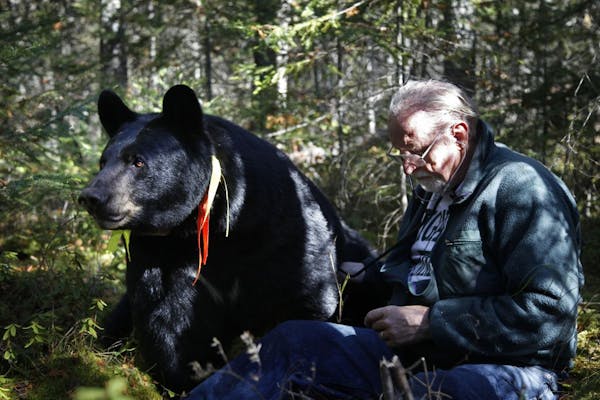In its disdain for Ely bear researcher Lynn Rogers, the Department of Natural Resources has launched itself into a deep chasm of regulatory pettiness.
At issue is a Minnesota Court of Appeals decision on Monday affirming the DNR has authority by permit to regulate Rogers' well-publicized bear research.
The appeals court decision stems from a suit Rogers filed against the DNR after his research permit was finally yanked in 2014. An administrative law judge ruled for the DNR last year; Rogers appealed; and the appeals court sided with the DNR, saying Rogers did in fact "possess'' bears when he placed collars on them, and needed a permit to do so.
Yet Monday's decision wasn't a complete loss for Rogers. Noting the widespread placement by hunters in the state's hinterlands of trail cameras, the court said Rogers didn't need a permit to place a camera in a bear den.
Some background:
• Rogers in 2010 first placed a winter "den cam'' in the den of a 3-year-old sow named Lily. At the time, he had a DNR permit to place telemetry collars on a limited number of bears he studied. Rogers fitted the collars on the bears without tranquilizers. Instead, most were habituated to humans with food from a young age. Subsequently, the animals allowed Rogers to enter their dens, "walk'' with them in the woods and even lie down while he changed collar batteries and took their heart rates.
• Lily gave birth to a cub named Hope on Jan. 21, 2010. At least 100,000 viewers worldwide watched via the Internet, and as they did, Rogers' fame grew.
• Similar births were broadcast by Rogers' den cams in 2011, 2012 and 2013, before the DNR prohibited a similar broadcast in 2014.
Throughout this period, relations between Rogers and the DNR deteriorated (they were never good), with the agency saying, among other things, that Rogers' collared bears represented a public safety threat. When the DNR finally pulled Rogers' research permit, it also cited a lack of peer-reviewed research and unprofessional conduct.
Disagreeing, Rogers filed suit, leading to Monday's appeals court decision.
All of which is the give-and-take of legal conflict resolution, except that Tuesday the DNR fired off a letter to Rogers' attorney underscoring state laws that say, "A person may not disturb the burrow or den of a wild animal between Nov. 1 and April 1 without a permit,'' and "a person may not take or disturb a bear in a den.''
Thus, the DNR said, "Any attempt to enter or in any way interfere with a bear den while a bear is in the den or between Nov. 1 and April 1, without a state permit, will be treated as a violation of state law and appropriate sanctions will be taken.''
Pretty precious stuff from an agency that Gov. Mark Dayton vowed would no longer be "arrogant'' under his administration.
No one, after all, will be entering a bear's winter hovel at least until bears den up this fall, a fact DNR Commissioner Tom Landwehr knows well.
So except for wanting to remind Rogers who's boss in these matters, what was the DNR's point in writing to him within 24 hours of the appeals court ruling?
Perhaps it's this: To torpedo any idea Rogers might have — or the DNR thinks he might have — of regaining the world's bear-research spotlight.
It is true that Rogers, while bright (a doctorate from the U), periodically marches to music few others hear, at times engendering unnecessary trouble for himself and his supporters.
But therein also explains his offbeat bear walks, den cams (which he pioneered with bears), and perhaps particularly the $3 million North American Bear Center near Ely that is his brainchild.
This much is agreed: The courts have ruled the DNR doesn't have to give Rogers a permit to collar bears.
But the agency risks its credibility and, not incidentally, its legislative support when it threatens to enforce, by withholding permits, the dates Rogers can enter dens simply to place and/or adjust cameras — this from an agency that has its own "den cams'' in eagle and falcon nests.
This also from an agency that routinely disturbs its research bear dens, and that last spring placed GPS radio collars on 25 moose calves immediately after they were born.
Subsequently, 19 of the calves were abandoned by their mothers, or their collars stopped working or fell off. The remaining six were killed by predators, prompting Dayton himself to end the study.
Rogers said Thursday he knows the whereabouts of about a dozen den sites in his study area. But finding a bear he has habituated in one of them will be tricky, because he no longer can track them via their collars.
By now, most people in Rogers' 76-year-old boots would have given up.
He won't.
Neither, probably, will the DNR.
Pettiness or persistence.
In the end, one will prevail.
Dennis Anderson danderson@startribune.com

Anderson: Trailblazing sonar will be in thousands of boats for opener

Anderson: Celebrate Earth Day by rekindling real connection to nature
Anderson: Anglers protesting tough new Mille Lacs rules are wrong

Anderson: Courts, not politicians, should rule on Red Lake, White Earth lands


